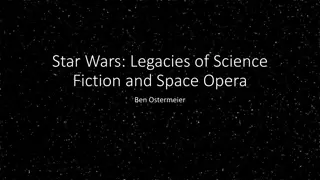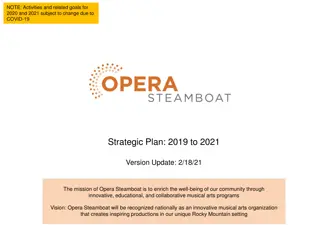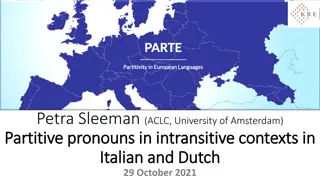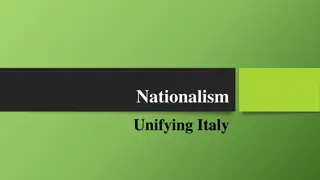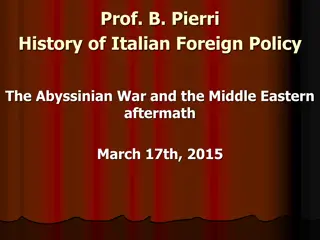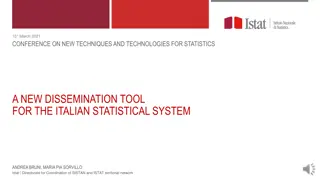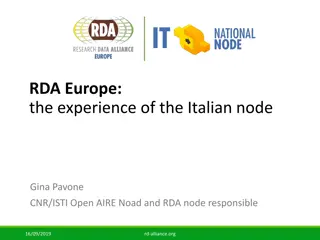Evolution of Opera: From Italian Camerata to Monteverdi and Purcell
Opera originated in late 16th century Italy, influenced by Greek tragedies and quickly gained popularity among aristocracy and general public by the mid-17th century. Baroque culture combined elements of literature, visual art, and music to create opera. The text in opera is vital for storytelling, with emphasis on homophony over polyphony. Different types of opera music include aria, recitative, ensemble, and overture. Monteverdi and Purcell are notable composers who expressed intense emotions through their operas Orfeo and Dido and Aeneas, respectively.
Download Presentation

Please find below an Image/Link to download the presentation.
The content on the website is provided AS IS for your information and personal use only. It may not be sold, licensed, or shared on other websites without obtaining consent from the author. Download presentation by click this link. If you encounter any issues during the download, it is possible that the publisher has removed the file from their server.
E N D
Presentation Transcript
Chapters 5, 6 Opera
Opera Overview Beginnings Late 16th C Italy Camerata s ideas for opera fr/ Greek tragedies v/ popular v/ quickly Aristocracy immediately Gen l pop by mid-17C
Opera Overview Baroque culture likes to combine ideas, elements, etc. So Literature story poetry libretto Visual Art sets scenery costumes acting Music vocal instrumental dance = Opera!
Opera Text is VIMP; it tells the story. Th/f, Homophony is IN Polyphony is OUT
Opera 4 types of opera music: Aria MELODY MIMP Plot stops Reflects on state of events or singer s emotions Orchestra accomp Complete piece of music Recitative TEXT MIMP Plot moves forward Tells story Basso continuo accomp Usually transitions to an aria or ensemble Ensemble 2-4 main characters sing often portrays contrasting moods simultaneously Overture orchestra should set mood often includes opera s melodies
Monteverdi Music must portray intense emotions. Orchestral effects intensify mood.
Chapters 7, 8 Monteverdi, L Orfeo Purcell, Dido and Aeneas
Overview Monteverdi Tu s morta from L Orfeo operatic recitative I= basso continuo accomp text expression of mournful mood: word painting dark tone color slow tempo
Purcell MIMP 17th C English composer Dido and Aeneas only opera
Didos Lament study guide Study resources: PowerPoint slides Connect Kamien Kamien listening guide in text Study guide on next 4 slides
Didos Lament study guide 1. Dido s Lament opens with a recitative. It uses just two instruments. What are they? Chording instrument: _____________ Bass: ___________ The term used for this accompaniment: ___________. 2. The aria opens with and features a ground bass. What is a ground bass? (see chapter and/or glossary) You are responsible to hear and recognize the ground bass. 3. Explain how the ground bass unifies the aria.
Didos Lament study guide 4. Text expression: 17thC listeners associated certain melodies or melodic patterns with specific emotions or moods. Two commonly used patterns express the text of Dido s Lament: A chromatically descending melody portrays grief or sorrow (and Baroque era listeners understood that). It happens that Dido s ground bass IS a chromatically descending melody. Th/f its 11 repetitions powerfully express the sorrowful text. The sighing gesture, a pattern of 2 or 3 tones that descend by step, portray sadness or a dejected spirit. The gesture, which sounds like a hopeless sigh, is everywhere in Dido in both the singer s line and orchestra accomp. 2 sighing gesture examples
Didos Lament study guide Using ConnectKamien: Here are 2 examples of the sighing gesture: 01:04 01:06 01:34 01:37 voice violins The strings play the sighing gesture many times. Cite 1 example between 02:11 and 02:52. 02:?? 02:?? What is the singer s text during this excerpt? Cite 2 examples between 03:01 and the piece s end. 03:?? 03:?? 04:?? 04:??
Review Purcell Dido s Lament from Dido and Aeneas operatic aria (w/ recitative opening) I= orchestra accomp ground bass unifies text expression of mournful mood: slow tempo minor key descending chromatic bass line sighing gesture

 undefined
undefined











